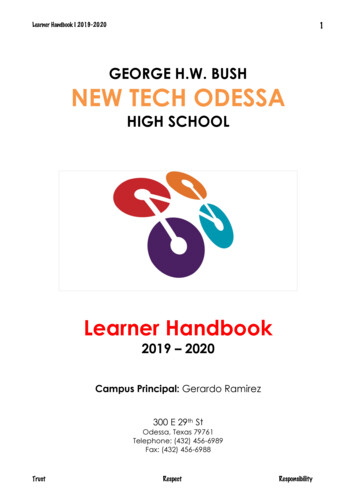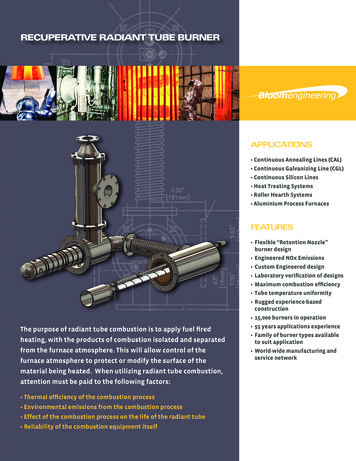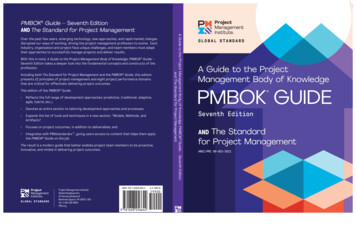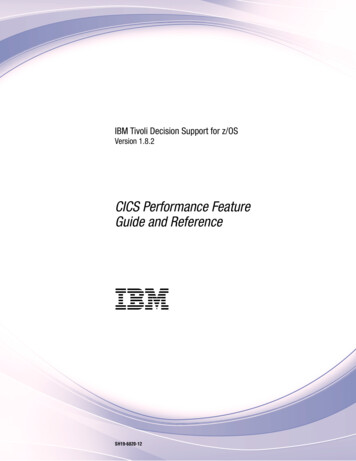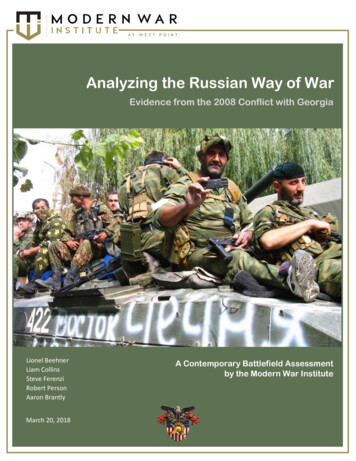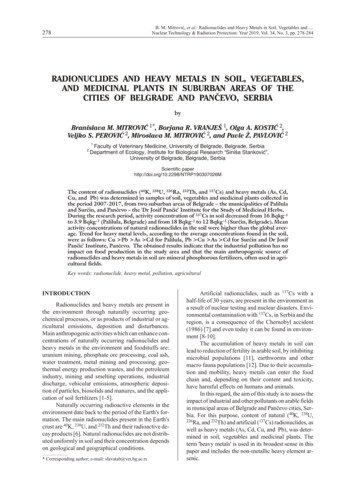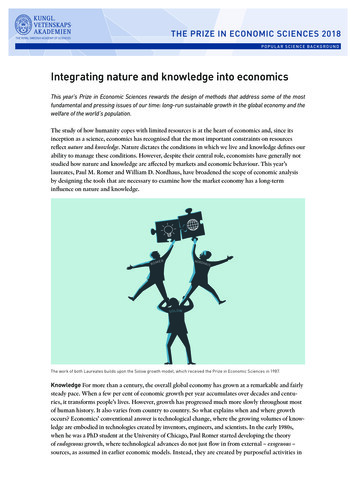
Transcription
THE PRIZE IN ECONOMIC SCIENCES 2018POPUL AR SCIENCE BACKGROUNDIntegrating nature and knowledge into economicsThis year’s Prize in Economic Sciences rewards the design of methods that address some of the mostfundamental and pressing issues of our time: long-run sustainable growth in the global economy and thewelfare of the world’s population.The study of how humanity copes with limited resources is at the heart of economics and, since itsinception as a science, economics has recognised that the most important constraints on resourcesreflect nature and knowledge. Nature dictates the conditions in which we live and knowledge defines ourability to manage these conditions. However, despite their central role, economists have generally notstudied how nature and knowledge are affected by markets and economic behaviour. This year’slaureates, Paul M. Romer and William D. Nordhaus, have broadened the scope of economic analysisby designing the tools that are necessary to examine how the market economy has a long-terminfluence on nature and knowledge.The work of both Laureates builds upon the Solow growth model, which received the Prize in Economic Sciences in 1987.Knowledge For more than a century, the overall global economy has grown at a remarkable and fairlysteady pace. When a few per cent of economic growth per year accumulates over decades and centuries, it transforms people’s lives. However, growth has progressed much more slowly throughout mostof human history. It also varies from country to country. So what explains when and where growthoccurs? Economics’ conventional answer is technological change, where the growing volumes of knowledge are embodied in technologies created by inventors, engineers, and scientists. In the early 1980s,when he was a PhD student at the University of Chicago, Paul Romer started developing the theoryof endogenous growth, where technological advances do not just flow in from external – exogenous –sources, as assumed in earlier economic models. Instead, they are created by purposeful activities in
the marketplace. Romer’s findings allow us to better understand which market conditions favour thecreation of new ideas for profitable technologies. His work helps us design institutions and policies thatcan enhance human prosperity by fostering the right conditions for technological development.Nature William Nordhaus began his work in the 1970s, after scientists had become increasinglyconcerned about how the combustion of fossil fuels causes serious global warming, and the detrimentaleffects of such climate change. Nordhaus took on the daunting task of examining bidirectional feedback loops between human activity and the climate, combining basic theories and empirical resultsfrom physics, chemistry, and economics. He thus not only regarded nature as a constraint on humanactivity, but also as something greatly influenced by economic activity. Nordhaus became the firstperson to design simple, but dynamic and quantitative models of the global economic-climate system,now called integrated assessment models (IAMs). His tools allow us to simulate how the economy andclimate would co-evolve in the future under alternative assumptions about the workings of nature andthe market economy, including relevant policies. His models address questions about the desirability ofdifferent global scenarios and specific policy interventions.Imperfections in the global market Both laureates highlight spillover effects on society, which areconsequences for others that were not taken into account by individual innovators or polluters. Anyidea for a new technology, wherever it originates, can be used for the production of new goods andother ideas in any other place, now or in the future. Similarly, a newly emitted unit of carbon, whatever its origin, quickly diffuses in the atmosphere and contributes to climate change, affecting all ofhumanity now and in the future. Economists refer to these types of spillover effects as externalities.The externalities studied by Romer and Nordhaus have global reach and long-term consequences. Asunregulated markets will generate inefficient outcomes in the presence of such externalities, the workof Romer and Nordhaus provides convincing arguments for government intervention.Technological innovationMotivation Long-term differences in growth rateshave staggering consequences when they occur.If two economies start out with equal GDP percapita, but one grows at a 4 per cent higher rate, itwill become almost five times richer in 40 years.A more modest 2 per cent growth advantagetranslates into twice as much national income in40 years.ROMERRomer’s research shows how the accumulation of ideassustains long-run economic growth.2(8)In the late 1980s, Romer observed that theincome growth rates in actual data vary greatlyfrom country to country. Figure 1, based one ofRomer’s papers, depicts income per capita in 1960and the average growth for the subsequent 25years for over 100 countries; a graph with contemporary data looks virtually identical. Each squarerepresents a country. As the figure shows, typicalgrowth-rate differences between countries wereseveral percentage points, and there is a huge gap –around ten percentage points – between the fastestand slowest growing countries. Moreover, theTHE PRIZE IN ECONOMIC SCIENCE S 2018 THE ROYAL SWEDISH ACADEMY OF SCIENCES W W W.KVA.SE
figure shows no systematic relationship between initial income and growth: some poor countries growrapidly, while others actually shrink. Romer concluded that understanding the causes of such persistentand significant growth-rate differences is crucially important, and started looking for an explanation.Average annual growth in incomeper capita, 1960-858%Singapore6%4%United States2%0%Figure 1: Income per capita (relative tothe US) in 1960 for over 100 countries(horizontal axis) and subsequent averageannual growth in income for 1960-85(vertical axis). Each square represents acountry. Data from Robert Summers andAlan ncome per capita relative to United States in 1960Empirical and theoretical shortcomings As Romer noted, the dominant growth theory at the time –the Solow growth model, which received the Prize in Economic Sciences in 1987 – could explain manyfeatures of economic growth, but not large and persistent differences in growth rates. The Solow modelpredicts that poorer countries should grow faster and catch up with richer ones quite quickly, whichis not what Figure 1 shows. In the model, an economy can grow by accumulating physical capital, forexample machines or infrastructure, but capital-driven growth must peter out in the longer term; forany given technology, adding more capital yields less and less additional output. To allow for persistent long-run growth (and growth differences) in the model, the assumption has to be that, over time,labour becomes increasingly productive due to technological advances, although at varying rates foreach country. Therefore, the Solow model does not explain these trends, because changes in technology simply arrive exogenously from a “black box”.A major breakthrough Romer’s biggest achievement was to open this black box and show howideas for new goods and services – produced by new technologies – can be created in the marketeconomy. He also demonstrated how such endogenous technological change can shape growth,and which policies are necessary for this process to work well. Romer’s contributions had a massiveimpact on the field of economics. His theoretical explanation laid the foundation for research onendogenous growth and the debates generated by his country-wise growth comparisons have ignitednew and vibrant empirical research.What’s special about ideas-driven growth? To answer that question, we must understand howideas are different to goods such as physical or human capital. Romer taught us to think about goodsusing two dimensions, as in Figure 2.In the first dimension, physical and human capital are rival goods. If a particular machine, or a trained engineer, is used in one factory, the same machine or engineer cannot be used at the same timein another factory. Ideas, on the other hand, are non-rival goods: one person or firm using an ideadoes not preclude others from using it too.In the second dimension, these goods may be excludable if institutions or regulations make it possible to prevent someone from using them. For some ideas, such as results from basic research, thisis difficult or even impossible – think about mathematical insights like the Pythagorean Theorem.THE PRIZE IN ECONOMIC SCIENCE S 2018 THE ROYAL SWEDISH ACADEMY OF SCIENCES W W W.KVA.SE3(8)
For other ideas, however, users can be excluded through technical measures (such as encryption) orpatent laws. Romer’s breakthrough article showed how the rivalry and excludability of ideas determine economic growth.RIVAL GOODSNONRIVAL GOODS100A can of soft drinkA coded satelliteTV broadcastA secret soft drink recipeDegree ofcontrol orexcludability(percent)A televisionComputer softwareFigure 2: Rival and excludable goodsFish in the deep oceansA GPS signalBasic R&D0The Pythagorean TheoremRomer believed that a market model for idea creation must allow for the fact that the productionof new goods, which are based on ideas, usually has rapidly declining costs: the first blueprint has alarge fixed cost, but replication/reproduction has small marginal costs. Such a cost structure requiresthat firms charge a markup, i.e. setting the price above the marginal cost, so they recoup the initialfixed cost. Firms must therefore have some monopoly power, which is only possible for sufficientlyexcludable ideas. Romer also showed that growth driven by the accumulation of ideas, unlike growthdriven by the accumulation of physical capital, does not have to experience decreasing returns. Inother words, ideas-driven growth can be sustained over time.Market imperfections and policy In principle, the new knowledge created by successful researchand development, R&D, can benefit entrepreneurs and innovators anywhere in the world, now andin the future. However, markets generally do not fully reward the creators of new knowledge for thefull benefits of their innovations, which means that – as long as the new knowledge is socially beneficial – too little R&D is conducted. Furthermore, as market incentives for R&D come in the formof monopoly profits, there will typically be inadequate provision of new goods once they have beeninvented. Subsequent research has shown how market outcomes may also entail too much R&D –either when new ideas kill off too many existing firms in a process of creative destruction, or whennew ideas augment socially harmful technologies, such as by enabling excessive extraction or use offossil fuels, thus harming the climate.To summarise, Romer showed that unregulated markets will produce technological change, but tendto underprovide R&D and the new goods created by it. Addressing this under-provision requireswell-designed government interventions, such as R&D subsidies and patent regulation. His analysissays that such policies are vital to long-run growth, not just within a country but globally. It alsoprovides guidelines for policy design: patent laws should strike the right balance between the motivation to create new ideas, by giving some monopoly rights to developers, and the ability of othersto use them, by limiting these rights in time and space.4(8)THE PRIZE IN ECONOMIC SCIENCE S 2018 THE ROYAL SWEDISH ACADEMY OF SCIENCES W W W.KVA.SE
Climate changeC Nordhaus’ research shows how economic activity interactswith basic chemistry and physics to produce climate change.Human activity has contributed to the rapidincreases in average global temperatures over thelast 100 years. While there is uncertainty aboutthe extent to which this will affect the climatein the future, natural scientists have reached aclear consensus that this is “in all likelihood, verysignificantly”.Motivation In the 1970s, when he was a youngfaculty member at Yale University, WilliamNordhaus keenly studied the emerging evidenceon global warming and its likely causes and concluded that he had to do something. His concernwas channelled into devising new tools to help usunderstand how the economy can generate climatechange, as well as the societal consequences ofclimate change. He wanted to develop a framework that allowed climate change to be analysedin terms of costs and benefits.A tall order Like Romer, Nordhaus extended the Solow growth model with an important set of spillover effects by including the global warming caused by carbon emissions. In this case, the relevantspillovers are predominantly negative. Crucially, the specific mechanisms and drivers of humaninduced climate change involve processes studied in the natural sciences. A global analysis of climatechange thus requires a truly integrated approach, in which society and nature dynamically interact.Recognising the need for such an approach, Nordhaus pioneered the development of integratedassessment models (IAMs). His models have three interacting modules:A carbon-circulation module This describes how global CO2 emissions influence CO2 concentration in the atmosphere. It reflects basic chemistry and describes how CO2 emissions circulatebetween three carbon reservoirs: the atmosphere; the ocean surface and the biosphere; and thedeep oceans. The module’s output is a time path of atmospheric CO2 concentration.A climate module This describes how the atmospheric concentration of CO2 and other greenhouse gases affects the balance of energy flows to and from Earth. It reflects basic physics anddescribes changes in the global energy budget over time. The module’s output is a time path forglobal temperature, the key measure of climate change.An economic-growth module This describes a global market economy that produces goodsusing capital and labour, along with energy, as inputs. One portion of this energy comes fromfossil fuel, which generates CO2 emissions. This module describes how different climate policies – such as taxes or carbon credits – affect the economy and its CO2 emissions. The module’soutput is a time path of GDP, welfare and global CO2 emissions, as well as a time path of thedamage caused by climate change.THE PRIZE IN ECONOMIC SCIENCE S 2018 THE ROYAL SWEDISH ACADEMY OF SCIENCES W W W.KVA.SE5(8)
A global dynamic system The three modules form a simple, but dynamically interactive model ofthe world. There are two versions of Nordhaus’ model: the Regional Integrated Climate-Economy(RICE) model, in which the economic-growth module has eight separate regions, and the simplified Dynamic Integrated Climate-Economy (DICE) model, where that module has a single region.Nordhaus’ IAMs can be used to simulate the consequences of business-as-usual policies or those ofvarious policy interventions. The models are also helpful in evaluating how to guide the market economy towards emission levels that properly balance societal costs and benefits. This question cannotbe addressed without a model in which – as in reality – humans are affected by the climate at thesame time as the climate is affected by humanity’s economic activities.Policy recommendations According to Nordhaus’ research, the most efficient remedy for theproblems caused by greenhouse gas emissions would be a global scheme of carbon taxes that areuniformly imposed on all countries. This recommendation builds upon a result formulated in the1920s by a British economist, A.C. Pigou, namely that each emitter should pay the societal cost ofthe damage caused by their emissions via an appropriate price. A global emission trading systemcan do the same job, provided that limits on emissions are set low enough to result in a high enoughprice for carbon.However, IAMs do not just provide qualitative results. Crucially, they allow us to calculate quantitative paths for the best carbon tax, and show how these paths depend on assumptions about parameters: e.g. how sensitive global temperature is to the concentration of carbon in the atmosphere, howlong it remains in the atmosphere, and the extent of the damage caused by climate change. A recentstudy by Nordhaus is a useful illustration of how an IAM can be employed to analyse policy. Hesimulates four policies in the latest version of DICE, using best-guess estimates for climate changeparameters:1. Base: no new climate change policiesbeyond those in place in 2015.Global industrial emmissions (GtCO2 /year)8070BaseOptT 2.5Stern2. Opt: carbon taxes that maximise globalwelfare, using conventional economicassumptions about the importance of thewelfare of future generations.6050403. Stern: carbon taxes that maximise globalwelfare, with substantially more emphasis on the welfare of future generationsthan in scenario 2, as suggested in TheEconomics of Climate Change: The SternReview, from 2007.302010020102025204020552070208521004. T 2.5: carbon taxes high enough to keepglobal warming from ever exceeding2.5 C are implemented at minimumglobal welfare cost.Figure 3: CO2 emissions over time for four climate policies (explanations in the text). Predictions from the DICE-2016R2 model,according to Nordhaus’ own simulations.Figure 3 shows CO2 emissions over time in each of these four scenarios. The different paths forcarbon taxes mean that emissions – and thus the extent of climate change – are very different acrossthese scenarios. In scenario 2, taxes start out at around 30 USD/ton CO2 and rise over time at aboutthe same rate as global GDP. In scenarios 3 and 4, which have much more drastic emission cuts,taxes are 6-8 times higher.6(8)THE PRIZE IN ECONOMIC SCIENCE S 2018 THE ROYAL SWEDISH ACADEMY OF SCIENCES W W W.KVA.SE
Huge uncertainties In both the natural sciences and the social sciences, there are uncertaintiesabout many aspects of climate change. For example, we do not know exactly how sensitive the climate is to greenhouse gas emissions, or how great the risk is of passing global tipping points beyondwhich the climate may spiral out of control. Similarly, we have incomplete knowledge about theeconomic and human damages caused by climate change and about the cost of de-carbonisation.Naturally, the IAMs developed by Nordhaus cannot eliminate this uncertainty. However, his modelscan analyse how the appropriate pricing of carbon is affected by different possibilities, such as higherclimate sensitivity or the higher probability of a dangerous global tipping point at 2 C of warming.Exciting research agendas Paul Romer’s and William Nordhaus’ contributions are crucial stepsforward in addressing central questions about the future of humanity. We do not yet have conclusiveanswers to these questions, but the laureates’ methods have been fundamental in allowing currentand future researchers to improve our understanding of the best way to progress towards sustainedand sustainable global economic growth.THE PRIZE IN ECONOMIC SCIENCE S 2018 THE ROYAL SWEDISH ACADEMY OF SCIENCES W W W.KVA.SE7(8)
LINKS AND FURTHER READINGAdditional information on this year’s prizes, including a scientific background in English, is available onthe website of the Royal Swedish Academy of Sciences, www.kva.se, and at http://nobelprize.org. There,and at www.kva.se/video, you can watch video footage of the press conferences, the Nobel Lectures andmore. Information on exhibitions and activities related to the Nobel Prizes and the Prize in EconomicSciences is available at www.nobelcenter.se.BooksNordhaus, W.D. (2015) the Climate Casino: Risk, Uncertainty, and Economics for a Warming World,Yale University PressWarsh, D. (2007) Knowledge and the Wealth of Nations, A Story of Economic Discovery, WW Norton & CoArticlesKrugman, P. (2013) Gambling with Civilization, the New York Review of limate-change-gambling-civilization/The growth of growth theory (2006) the , P.M. (1994) The Origins of Endogenous Growth, The Journal of Economic Perspectives, Vol. 8, No1https://www.aeaweb.org/articles?id 10.1257/jep.8.1.3Romer, P.M. (1993) Two Strategies for Economic Development: Using Ideas and ProducingIdeas, in Proceedings of the World Bank Annual Conference of Development Economics 1992,Washington, DC: World 181468739245145/pdf/multi0page.pdfVideoWhat Will Climate Change Do to the Economy? (2014) an interview with William Nordhaus,Yale School of Managementhttps://www.youtube.com/watch?v fOTLjYxd-2YThe Royal Swedish Academy of Sciences has decided to award the SverigesRiksbanks prize in Economic Sciences in Memory of Alfred Nobel 2018 toWILLIAM D. NORDHAUSPAUL M. ROMERborn 1941 in Albuquerque, USA.Ph.D. in 1967 from Massachusetts Institute ofTechnology, Cambridge, USA. Sterling Professor ofEconomics, Yale University, New Haven, USA.born 1955 in Denver, USA.Ph.D. in 1983 from University of Chicago, USA.Professor at NYU Stern School of Business, NewYork, or integrating climate change into long-runmacroeconomic analysis”“for integrating technological innovations intolong-run macroeconomic analysis”Science Editors: John Hassler, Per Krusell, Torsten Persson and Per Strömberg, the Committee for the Prize in Economic Sciences in Memory of Alfred NobelIllustrations: Johan Jarnestad/The Royal Swedish Academy of SciencesProofreading: Clare BarnesEditor: Sara Gustafsson The Royal Swedish Academy of Sciences8(8)THE PRIZE IN ECONOMIC SCIENCE S 2018 THE ROYAL SWEDISH ACADEMY OF SCIENCES W W W.KVA.SE
the US)n 1960 for over 100 countries (horizontal axis)nd subsequent average annual growth in income for 1960-85 (vertical axis). Each square represents a
